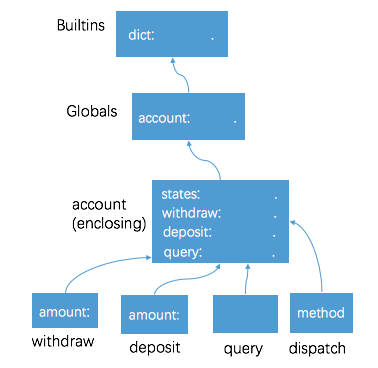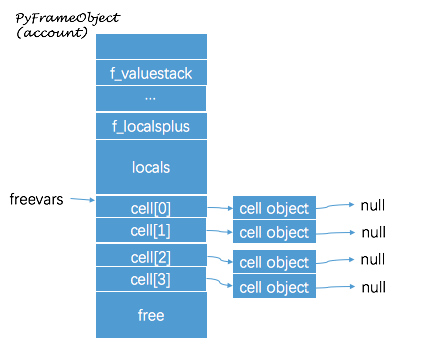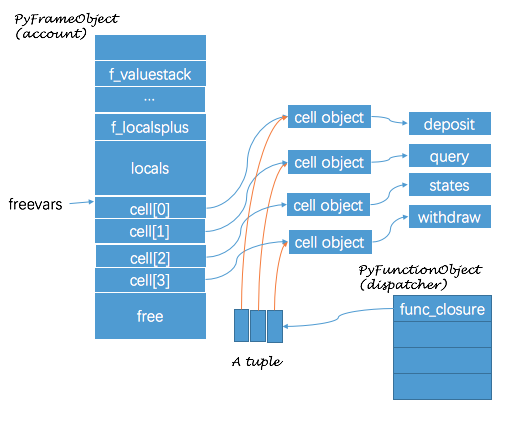Jacky
教土豆学计算机
Function 函数
Functions in Python are first-class objects.
在 Python 中, 函数是第一级对象, 一等公民; 可以作为函数的参数, 也可以作为函数的返回值
lambda
An anonymous function 匿名函数
Closure 闭包
纯函数(无副作用)是函数的输出仅依赖于输入, 不依赖于外部环境, 也不改变外部环境; 但有时函数也需要状态
In CPython, a closure is a function that retains the bindings of the free variables that exist when the function is defined.
引入闭包后, Python 的作用域规则成了 LEGB (Local -> Enclosing -> Global -> Builtin)
下面举一个极度简化版的银行账户例子, 通常我们会用 OO 中类来模拟; 这里我们尝试用闭包来实现: account() 来模拟账户, balance 是账户余额, 即为状态; 其支持存款 deposit, 取款 withdraw, 查询 query 操作.
def account(balance):
# In Python 2.x, the nested function only could modify mutable variables
states = {'balance': balance}
def withdraw(amount):
if states['balance'] > amount:
states['balance'] -= amount
else:
raise RuntimeError('No sufficient balance!')
def deposit(amount):
states['balance'] += amount
def query():
return states['balance']
def dispatch(method):
if method == 'withdraw':
return withdraw
elif method == 'deposit':
return deposit
elif method == 'query':
return query
else:
raise RuntimeError('Unsupported method ' + method)
return dispatch
因为在 Python2.x 中内部函数不能直接给 enclosing 作用域里的变量赋值(或者说绑定新值), 所以上面的代码中用 states 包装了一下 balance. Python3 中可以使用 nonlocal 关键字;
对于 withdraw 来说, amount 是参数, 作为函数的局部变量; 而 states 是在函数外部定义的, 属于自由变量 free vars; 同理, 对于 dispatch 来说, 参数 method 是局部变量, 而 withdraw, deposit, query 则是自由变量;
执行以下代码
>>> tom = account(100)
<function dispatch at 0x101a1c668>
>>> tom('withdraw')(20)
在 withdraw, deposit, query, dispatch 函数的内部求值环境(作用域)如下图示, 想想为什么状态(上下文)在内部函数间是共享的?

How CPython implements closure
在执行 account(100) 时, CPython 首先会基于 account function 创建一个新的 Frame; CPython 会在 Frame free vars 区域分配 4 个 cell object, 正是通过这 4 个 cell object, 使得内部函数 withdraw 等可以引用到上下文
>>> account.func_code.co_cellvars
('deposit', 'query', 'states', 'withdraw')

我们可以通过 dis.dis(account) 看到 account 函数体对应的字节码
3 0 BUILD_MAP 1
3 LOAD_FAST 0 (balance)
6 LOAD_CONST 1 ('balance')
9 STORE_MAP
10 STORE_DEREF 2 (states)
5 13 LOAD_CLOSURE 2 (states)
16 BUILD_TUPLE 1
19 LOAD_CONST 2 (<code object withdraw at 0x10029ce30...>)
22 MAKE_CLOSURE 0
25 STORE_DEREF 3 (withdraw)
11 28 LOAD_CLOSURE 2 (states)
31 BUILD_TUPLE 1
34 LOAD_CONST 3 (<code object deposit at 0x100722630...>)
37 MAKE_CLOSURE 0
40 STORE_DEREF 0 (deposit)
14 43 LOAD_CLOSURE 2 (states)
46 BUILD_TUPLE 1
49 LOAD_CONST 4 (<code object query at 0x100722130...>)
52 MAKE_CLOSURE 0
55 STORE_DEREF 1 (query)
17 58 LOAD_CLOSURE 0 (deposit)
61 LOAD_CLOSURE 1 (query)
64 LOAD_CLOSURE 3 (withdraw)
67 BUILD_TUPLE 3
70 LOAD_CONST 5 (<code object dispatch at 0x1007ce1b0...>)
73 MAKE_CLOSURE 0
76 STORE_FAST 1 (dispatch)
27 79 LOAD_FAST 1 (dispatch)
82 RETURN_VALUE
可以看到指令 10, 25, 40, 55 处使用 STORE_DEREF 来依次填充 cell 0 ~ 3
TARGET(STORE_DEREF)
{
w = POP();
x = freevars[oparg];
PyCell_Set(x, w);
Py_DECREF(w);
DISPATCH();
}
指令 58 - 76 对应的是 def dispatch, 首先执行 LOAD_CLOSURE 获取 deposit, query, withdraw 关联的 cell object, 而后创建一个 tuple 来存储这些 cell
TARGET(LOAD_CLOSURE)
{
x = freevars[oparg];
Py_INCREF(x);
PUSH(x);
if (x != NULL) DISPATCH();
break;
}
接着 MAKE_CLOSURE 会创建一个闭包 (函数代码 + 上下文); MAKE_CLOSURE 会设置函数对应的 func_closure, 其取值可为 Null 或者 tuple, 包含一组 Cell object; 在上例中, tom.func_closure 里存储着 3 个 cell, 分别对应着 deposit, query, withdraw.
>>> tom.func_closure
(<cell at 0x1007e3bb0: function object at 0x10191c320>, <cell at 0x1007e3be8: function object at 0x10191c398>, <cell at 0x1007e3c58: function object at 0x10191c2a8>)
>>> for e in tom.func_closure: print e.cell_contents
<function deposit at 0x10221c320>
<function query at 0x10221c398>
<function withdraw at 0x10221c2a8>

到目前为止, 我们理解了闭包的实现机制, 猜猜下面的代码块会输出什么呢? 简单提示: lambda 的函数体是 i * i, 且 i 是自由变量
def calc_square():
return [lambda: i * i for i in range(3)]
for e in calc_square():
print e()
Decorator 装饰器
A decorator is a callable that takes another function as argument, use the @syntax. Mastering it requires understanding closures.
@dec2
@dec1
def func(arg1, arg2, ...):
pass
This is equivalent to:
def func(arg1, arg2, ...):
pass
func = dec2(dec1(func))
though without the intermediate creation of a variable named func